3 euro - Styracosaurus albertensis – the longest horn
Series: Austria - Supersaurs

They may have looked terrifying but the spikes and horns that protruded from the head of Styracosaurus albertensis were not necessarily used for violent purposes. The subject of the eighth coin in the Supersaurs series had four to six long spikes extending from its neck frill, a smaller horn on each cheek, and a single horn, up to 60 cm long and 15 cm wide, protruding from its nose. The function of those horns has long been the subject of scientific debate.
In the case of some horned dinosaurs, horns certainly served as defence in the event of attack, although the neck frill would have been punctured quickly in combat. Bite marks of a Tyrannosaurus rex have been found on the frill of a Triceratops, for example. Another possibility is that males with bigger, more elaborate and more visible headgear had a better chance of intimidating their rivals in the herd and attracting available females during the mating season. The frills may also have been decorated with eye-catching patterns and bright colours, which could have served as a distinguishing feature or helped established the hierarchy within the herd. Who knows, they may also have served to impress their enemies to the extent that they would not even consider attacking Styracosaurus in the first place.
Styracosaurus albertensis features all 12 of the extreme prehistoric animals in the Supersaurs series in silhouette on its obverse, while a colour-printed Styracosaurus is followed by a snarling Tyrannosaurus rex in the background of the coin’s glow-in-the-dark reverse. The 3 euro Supersaurs coins are legal tender in Austria.